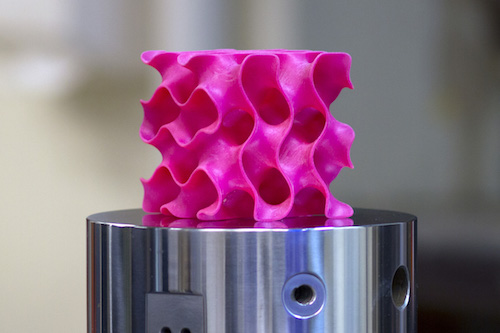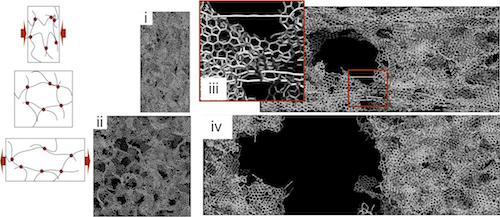MIT 3D Graphene Material Opens Up Lightweighting Possibilities

3D-printed gyroid models such as this one were used to test the strength and mechanical properties of a new lightweight material created at MIT. Image Courtesy of Melanie Gonick/MIT
Latest News
January 24, 2017
Graphene, widely hailed for its strength, has not been readily harnessed for lightweighting applications in automotive or electronics product design primarily because the existing atom-thin 2D materials haven’t been adapted to deliver adequate structural stability.
That scenario may change thanks to a recent development by researchers at MIT. The team was able to design a lightweight graphene material through a process that compressed and fused graphene flakes into a porous, sponge-like 3D form that boasts 5% of the density of steel, but is nearly 10 times stronger, according to a study published in the Science Advances journal.
Using a combination of heat and pressure, the MIT research team created a 3D structure similar to corals and microscopic creatures called diatoms, the researchers said. The shapes turn out to have a large surface area in proportion to their volume—a design decision that resulted in a structure that delivers the strength and stability that was so elusive with straight up 2D graphene.
 3D-printed gyroid models such as this one were used to test the strength and mechanical properties of a new lightweight material created at MIT. Image Courtesy of Melanie Gonick/MIT
3D-printed gyroid models such as this one were used to test the strength and mechanical properties of a new lightweight material created at MIT. Image Courtesy of Melanie Gonick/MITBecause of the extraordinary thinness of 2D graphene sheets, “they are not very useful for making 3D materials that could be used in vehicles, buildings, or devices,” noted Markus Buehler, the head of MIT’s Department of Civil and Environmental Engineering (CEE) and the McAfee Professor of Engineering, in a press release announcing the new finding. Moreover, the team said the strength targets achieved had less to do with the use of graphene and more to do with the usual geometric configuration, which opens the door to using a similar process to create other lightweight, strong materials, researchers said.
While other research teams had strived for similar lightweight structures, they kept running into problems in the lab, with experiments not matching up to their predictions and with strength targets reaching far lower levels than expected. This MIT team tried a different approach, analyzing the material’s behavior at an individual atom level, which enabled them to produce a mathematical framework that turned out to closely match their observations during the experiments, the researchers said.
Before the physical tests, the researchers conducted a range of simulations to mimic the loading conditions in tensile and compression tests performed in a tensile loading machine. In addition, the 3D structures were also produced on a multi-material 3D printer so they could be tested, and their mechanical response under loading was simulated using the team’s theoretical models—a process that resulted in an accurate match, the researchers said.
 Simulation results of tensile and compression tests on 3D graphene created at MIT. Image Courtesy of Zhao Qin/MIT
Simulation results of tensile and compression tests on 3D graphene created at MIT. Image Courtesy of Zhao Qin/MITThe team compared the resulting 3D form to a sheet of paper, which has little strength along its length and width, allowing it to be easily crumpled up. However, when paper is rolled into a tube, the strength ratio becomes much greater, allowing it to support additional weight. In this case, the model composed of thinner, more flexible walls failed gradually compared to the model with thicker, stronger walls, which collapsed more violently under pressure.
Researchers say the ability to tune the mechanics of materials simply by adjusting its geometry opens the door to a wide variety of practical applications where you need strong, lightweight materials like those for cars and buildings. Moreover, because of the porous nature of the structures, MIT researchers said the process and material is also well suited to filtration and energy storage applications.
“You could either use the real graphene material or use the geometry we discovered with other materials like polymers or metals,” Buehler said in an article on the MIT News site. “You can replace the material itself with anything—the geometry is the dominant factor.”
Watch this video to learn more about MIT’s graphene research.
Subscribe to our FREE magazine, FREE email newsletters or both!
Latest News
About the Author
Beth Stackpole is a contributing editor to Digital Engineering. Send e-mail about this article to [email protected].
Follow DE





